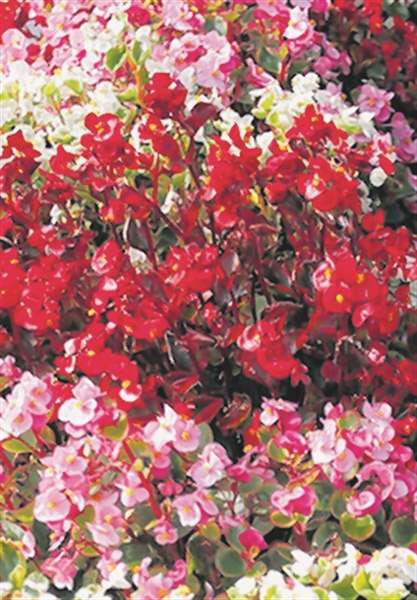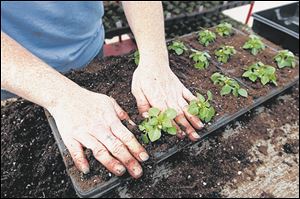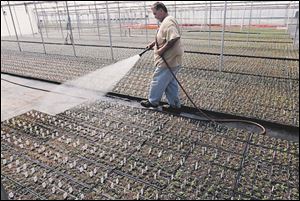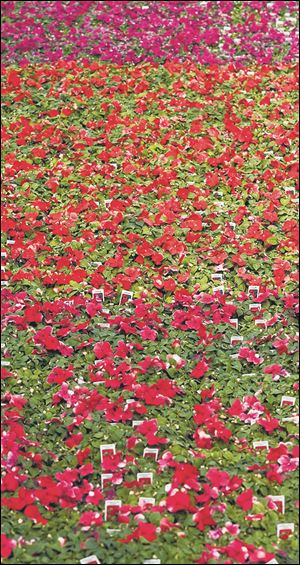
A Beautiful Mystery: Experts can't say if downy mildew will strike impatiens again this year
5/4/2014
FEA wiardorothy25p Dorothy Kott, 80, planted several colors of Begonias at the home she and her son, Gary, share in Toledo. The flowers have attracted the attention of neighbors and passersby alike. THE BLADE/KATIE RAUSCH
THE BLADE/KATIE RAUSCH
Buy This Image

LIV impatiens08p 04/08/2014 The Blade/Lori King Rhonda Cook plants pastels impatiens at Tom Strain & Sons (Daughter Too) Farm Market and Garden Center in Toledo.
The pathological (meant purely in the scientific sense) jury is still out on a pretty little blossom that became America's most popular bedding plant in just 40 years.

LIV impatiens08p 04/08/2014 The Blade/Lori King Long-time worker Joe Barrera waters impatiens at Tom Strain & Sons (Daughter Too) Farm Market and Garden Center in Toledo.
The verdict on impatiens walleriana, sold by the millions because it's marvelous at providing waves of color in shady areas where scant will grow, is likely to be unknown for years. That's due to several factors, not the least of which is Mother Nature's temperamental weather.
"It is a very unusual disease, it absolutely clobbers the plant," said Marjory Daughtrey, plant pathologist at Cornell Universities. She studies the aggressive pathogen called impatiens downy mildew (Plasmopara obducens), that caused commercial landscapers to back off from planting their usual numbers of impatiens and several flower producers to stop or reduce planting the seed in 2013 and 2014.
"We had a long run with that plant but it won't be as important in the future; it won't be as risk-free," said Ms. Daughtrey, adding that our frigid winter past probably did not wipe out this virile spore.
Downy mildew flourishes in moist, cool (about 59 to 73 degrees) weather. In our area, it showed up with a vengeance in 2012, when some gardens lost thousands of plants in just days. The deadly bug attacks leaves, stems, and flowers, and has been found in two-thirds of the states, including last year in normally arid places such as Utah, Oklahoma, and Colorado, which experienced floods.

But 2013 was a surprise to local greenhouse owners who continued raising thousands of flats such as Tom Strain and Bob Schmidt. They didn't hear word one about downy mildew affecting the plants they grew.
"We shipped to 18 customers in six states and didn't hear of any problems," said Mr. Strain. He'd reduced his impatiens crop from 30,000 to 12,000 flats last year. But raising them to be healthy comes at a new cost: in 2013 and again this year, they're sprayed every 7 to 10 days in the greenhouse with a fungicide and are checked weekly by a state inspector.
Perhaps because plants were cleaner when they came out of greenhouses last year, downy mildew was quite subdued. However, Colleen Warfield spotted two infected impatiens beds in downtown Columbus while at the Ohio Florist Association conference last summer.
"I think we'll see it again this year but it depends on the weather; my guess would be [affected plants in] August and September," said Ms. Warfield, corporate plant pathologist at Ball Horticultural Co. in West Chicago, Ill. "We don't have good evidence about what the trigger is."
In 2013, she planted impatiens in beds that had had infected plants in 2012, and the 2013 plants fared well until late in the season.

LIV impatiens08p 04/08/2014 The Blade/Lori King Impatiens for sale at Tom Strain & Sons (Daughter Too) Farm Market and Garden Center in Toledo.
So what's a gardener to do?
Caveat emptor. If you really want impatiens, grow your own from seed. Or, mix in other plants to soften your visual and financial loss in case the spore strikes, said Ms. Warfield. If you've lost impatiens to downy mildew before, it makes sense to plant something else this year, including other varieties of impatiens such as New Guineau or sunpatiens, she said.
And if you do notice impatiens turning yellow and getting wasted in a few days, bag up what's left of the plants and their soil, tie the bag shut, and put it in the trash. Do not put it in compost. Report it to the place you purchased them and to the OSU Extension Master Gardener volunteer horticultural hotline at 419-578-6783 or mghotline@ag.osu.edu.
Contact Tahree Lane at tlane@theblade.com or 419-724-6075.